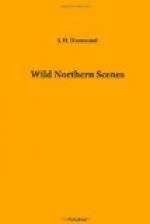CHAPTER XII.
THE FIRST CHAIN OP PONDS—SHOOTING BY TURNS—SHEEP WASHING—A PLUNGE AND A DIVE—A ROLAND FOR AN OLIVER.
We started early the next morning up Bog River, intending to reach the “first chain of ponds,” some twenty miles deeper in the wilderness, as the stream runs, on the banks of which our pioneer had been instructed to pitch our tents. This day’s journey, it was understood, would be a hard one, as there were eight carrying places, varying from ten rods to half a mile in length. The Bog River is a deep, sluggish stream for five or six miles above the falls, just at the lake. It goes creeping along, among, and around immense boulders, thrown loose, as it were, in mid channel. At this distance, the stream divides, the right hand channel leading to the two chains of ponds and Mud Lake, where it takes its rise; and the left to Round Pond, and little Tupper’s Lake, and a dozen other nameless sheets of water, laying higher up among the mountains. Our course lay up the right hand channel, which, for half a mile above the forks, comes roaring and tumbling through a mountain gorge, plunging over falls, and whirling and surging among the boulders, in a descent of three of four hundred feet in all. Around these, and seven other rapids of greater or less extent, our boats had to be carried.
We reached the lower chain of ponds within an hour of sunset, and found our tents pitched at a pleasant spot which looked out over the easternmost one of these beautiful little lakelets. There are three of them, connected together by narrow passages or straits, the banks of which, as the boat glides along, the oars will touch. They are surrounded by low but pleasant hills, so arranged as to form a varied but delightful scenery. From the western one, the hills rise from the water with a steep acclivity, covered with a gigantic growth of timber, save on the northern side, where a pleasant natural meadow, covered with rank grass and a few spruce and fir trees, stretches away. It contains about two hundred acres, and its waters are deep and pure. The middle one, though smaller, is equally beautiful, skirted on three sides with wood-covered hills, and on the other by a continuation of the same natural meadow. The eastern one, on the western banks of which our tents were located on a beautiful little bay, is the prettiest of them all. It contains perhaps six hundred acres, and the scenery around it is exceedingly cheerful and pleasant. The northern shore is bound by a natural meadow of luxuriant wild grass, between which and the water is a hard sandy beach, at low water some thirty feet wide, and extending between a quarter and half a mile in length.




